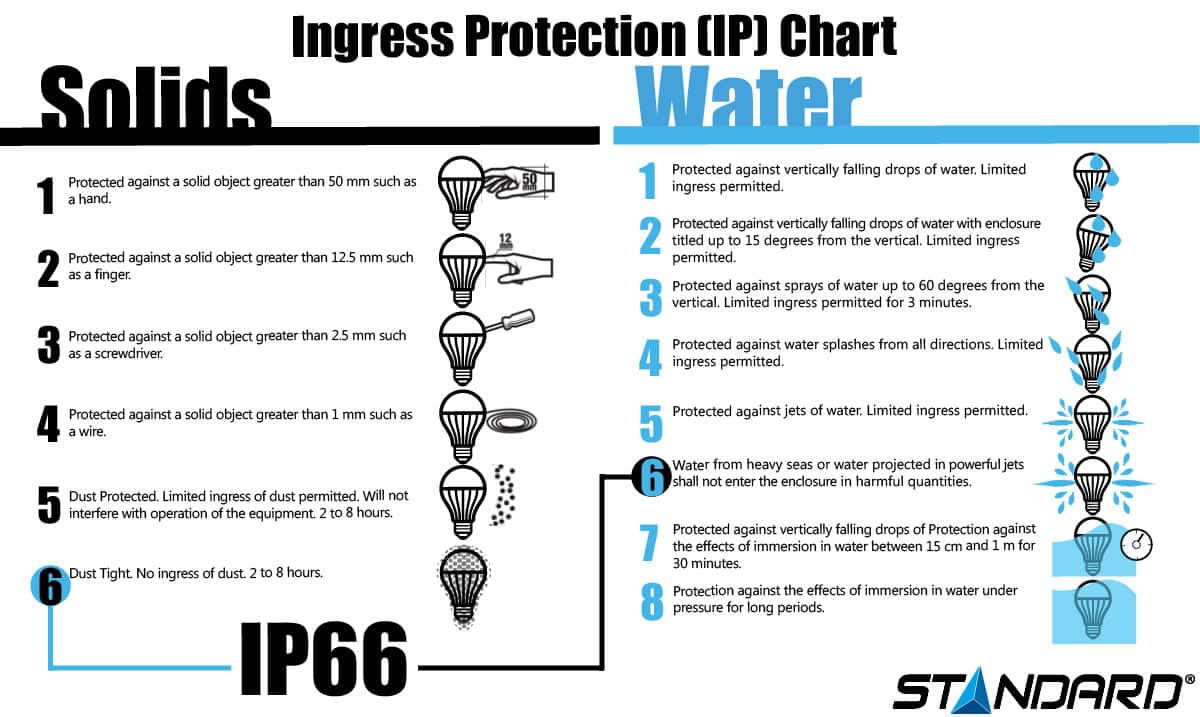The IP chart or International Protection Standard consists of the letters IP and 2 numbers. As prescribed by the CEI 6529 standard, the charter classifies the degree of protection of a product against the intrusion of two types of elements in electrical components: solid and liquid particles.
The primary purpose of the IP chart is to supply more accurate information than often imprecise marketing terms like “waterproof”.The Numbers
First Number: Solids
The first number in the IP chart indicates the degree of protection that the product’s enclosure provides against the intrusion of solid objects. It includes certain human body parts such as hands and fingers, as well as dust and accidental contact, etc. The first digit of the index starts at 0, indicating that there is no particular protection; and ends at 6, indicating that the product is completely protected against the intrusion of any dust. Here’s the chart breakdown for the first number (solids):- Protected against a solid object great than 50mm such as a hand
- Protected against a solid object greater than 12.5mm such as a finger
- Protected against a solid object greater than 2.5mm such as a screwdriver
- Protected against a solid object greater than 1mm such as a wire
- Dust protected. Limited ingress of dust permitted. Will not interfere with operation of the equipment. 2 to 8 hours.
- Dust tight. No ingress of dust. 2 to 8 hours.
Second Number: Liquids
The second number in the IP chart indicates the equipment’s degree of protection against water penetration and humidity. The second digit of the protection index starts at 0, meaning that there is no protection against water or humidity; and ends at 8, specifying that the product can withstand being completely submerged for a long period of time. Here’s the chart breakdown for the second number (liquids):- Protected against vertically falling drops of water. Limited ingress permitted.
- Protected against vertically falling drops of water with enclosure tilted up to 15 degrees from the vertical position. Limited ingress permitted.
- Protected against sprays of water up to 60 degrees from the vertical position. Limited ingress permitted for 3 minutes
- Protected against water splashes from all directions. Limited ingress permitted.
- Protected against any jet of water. Limited ingress permitted.
- Water from heavy seas or water protected in powerful jets shall not enter the enclosure in harmful quantities.
- Protected against vertically falling drops of water. Protection against the effects of immersion in water between 15cm and 1m for 30 minutes.
- Protections against the effects of immersion in water under pressure for long periods of time.
Example: IP66
In the case of a fixture that is IP66-certified, such as the vapor-tight LED fixture, this means the fixture is protected against dust, that there will be no intrusion of foreign matter for 2 to 8 hours, and that the fixture is protected against rough seas or strong water sprays. Thus, when analyzing lighting in an application such as a car wash, it will be essential to install a lighting product that is resistant to dust and to strong jets of water. You can evaluate and select the classification from the IP chart that indicates the level of protection required for your application.
Thus, when analyzing lighting in an application such as a car wash, it will be essential to install a lighting product that is resistant to dust and to strong jets of water. You can evaluate and select the classification from the IP chart that indicates the level of protection required for your application.
